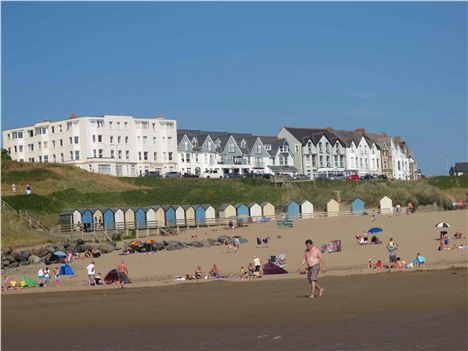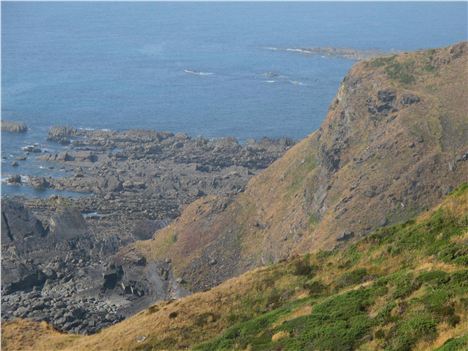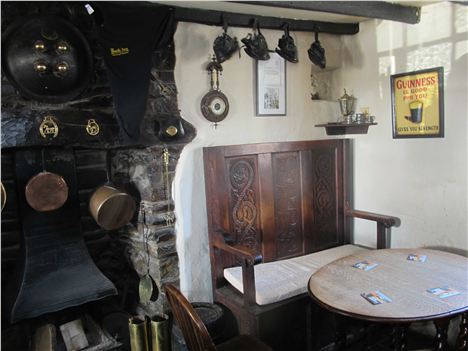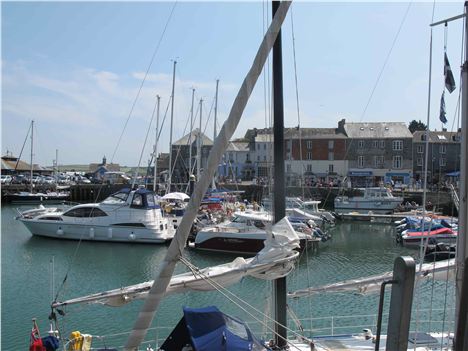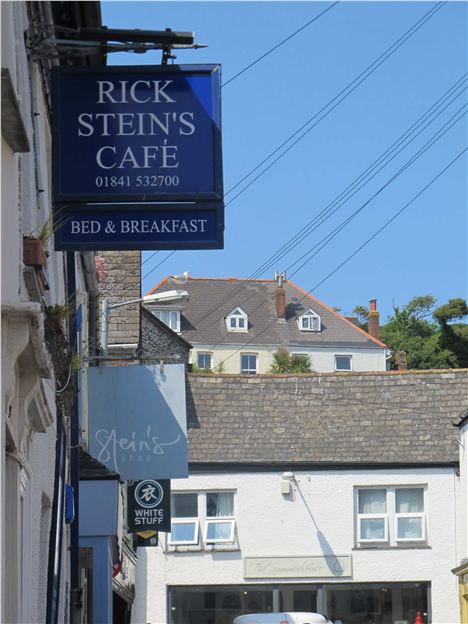AMONG my most lasting traveller’s memories is a 100 mile cliff trek along the South West Coastal Path in May 1997. From Westward Ho to Padstow. A week of unblemished blue skies and stretched calves. The finishing line was the Padstow restaurant of one Rick Stein, then basking in the acclaim for his early TV series, but the high point en route was Labour returning to power after 18 years.
'Out down the precipitous Morwenstow cliffs is the Rev Hawker’s Hut, a shed where he smoked opium dressed as a mermaid'
I watched the election on telly with my B&B host, a Cornish nationalist farmer, and several bottles of red high above Boscastle and the sea... then, bleary-eyed next morning, toasted the triumph again on the ramparts of Tintagel Castle. It seems so long ago. The Tide of Idealism soon smashed on the Cynics’ Rocks.
 Gull, PadstowNever go back, they say. Why not? The plan – three generations, two families, together under one roof in a large remote house with easy access to that North Cornwall Coast I so grew to love. First UK cottage holiday in decades.
Gull, PadstowNever go back, they say. Why not? The plan – three generations, two families, together under one roof in a large remote house with easy access to that North Cornwall Coast I so grew to love. First UK cottage holiday in decades.
A risk, it turned out to be the perfect holiday – with the most sublime summer weather contributing greatly. Even “Not that old tale again about your epic cliff walk, Dad” couldn’t blemish the idyll.
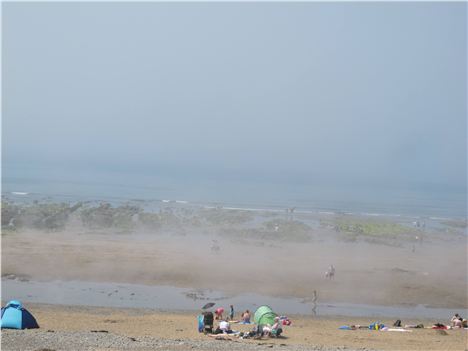 Sea fret finally lifting at Widemouth
Sea fret finally lifting at Widemouth
Our base was Ogbeare Coach House, North Tamerton, on the Cornwall-Devon border 10 miles from Bude. We were renting a four-bedroom wing of a converted 18th century building on a country estate. The “Big House”, Ogbeare Hall, was only a dense thicket away but we never grasped that until we were leaving. An outdoor hot tub and a huge secluded garden seduced us immediately; the rambling wooded estate was perfect for dog walks.
If it wasn’t exactly convenient – nearest pub two miles away, local shop considerably further – it provided the tranquil chill-out zone that disparate family members had all been seeking. The chance to tan in England definitely a bonus.
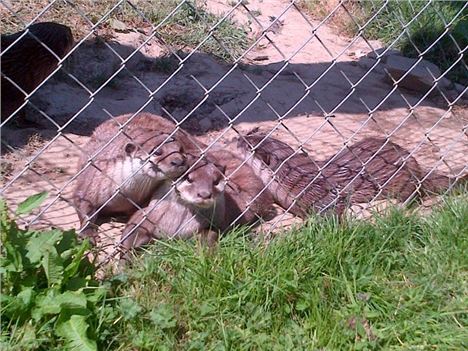 Otters are a fascinating family attraction
Otters are a fascinating family attraction
We were luckily close to the Tamar Otter Park, just down the Launceston Road at North Petherwin. It’s very much a hands-on experience and granddaughter Bella was entrabnce by her encounters with wallabies, deer, owls and, of course, otters.
The nearest beach, a Blue Flag, was at Widemouth Bay, a maze of country roads away. After a large lingering breakfast on the first day proper, we meandered over, purchasing buckets and spades en route. This is surfing country and we paid for car parking at a beach bum’s cafe on the dunes. Then came a bit of a shock.
We’d noted the haze when driving in, but only after cresting the rocks above the strand were we engulfed in an eerie sea fret, the yellow sail boards flitting in and out of the mist. It lifted, naturally, just when we had to leave for a late lunch. Fortunately it hadn’t hampered the younger generation’s sandcastle building.
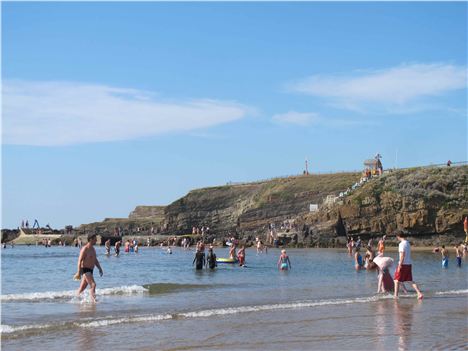 Bude seashore; below the beach huts
Bude seashore; below the beach huts
Further north, Bude, on the surface a strung-out traditional resort, has also embraced the surfer culture, noticeably around Crooklets Beach. We took in the more sheltered Summerleaze Beach below the town, which boasts an outdoor pool that fills with sea water at high tide. There’s a lovely walk along the Bude Canal, remnant of an ambitious 19th century waterways scheme that came to naught.
Pleasant, but my favourite spot along the whole rugged coast lies another 10 miles north off the extravagantly named (mostly inland) Atlantic Highway. I turned off too early and got lost among a muddy maze of single track roads, often penumbral under hedge canopies. But, after some hair-raising blind bends, Morwenstow was worth it. Home of a personal hero I had to introduce my brood to.
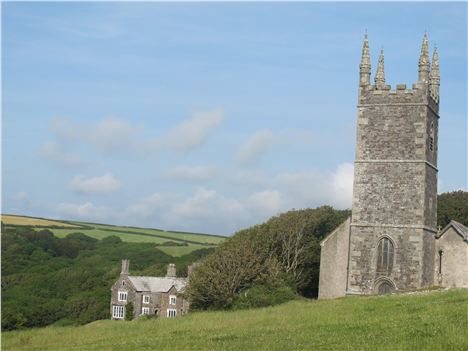 Hawker's Church and Vicarage, below, the sheer cliffs below
Hawker's Church and Vicarage, below, the sheer cliffs below
The legacy of Robert Hawker, eccentric 19th century vicar of the parish, is surprisingly abundant. His church is still there in a valley descending from the village to the sea, below it the Gothic Vicarage, now a posh B&B, still sports a set of chimneys mimicking the towers of Oxford Colleges and out down the cliffs is Hawker’s Hut, a shed where he smoked opium dressed as a mermaid. (More on his dress sense below).
Poet, reviver of harvest festivals, an incumbent (1834-75) who took his pet pig with him on parochial visits and a rescuer of drowning sailors off this notorious wreckers’ coast, he casts a long shadow on this remote spot.
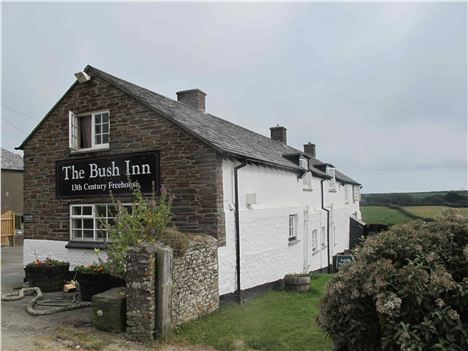 The Bush Inn; below, its cosy interior
The Bush Inn; below, its cosy interior
I can imagine the Bush Inn looked pretty much the same in Hawker’s time, bar the modern dining room added to this atmospheric 700-year-old former pilgrims’ halt and smugglers’ haunt.
Today it is hugely hospitable, with simple locally sourced food (the whole crab salad recommended) and a good choice of cask ale. Above all it was terrifically welcoming to a two-year-old grandchild and a chihuahua, the former romping around the outdoor play area.
From the pub, which has plenty of accommodation, there’s a two mile circular walk, part of it along the Coastal Path (shut up, Dad), along the clifftop and back past the church, vicarage and highly recommended Rectory Tea-rooms.
 Padstow from the Rock side of the Camel; below, a hot spot on the front
Padstow from the Rock side of the Camel; below, a hot spot on the front
 A quite different North Cornwall was on display on a day trip south. Rock was heaving. I’m sure all was calm and gastronomic in Nathan Outlaw’s celebrated restaurant (next time if I save up!), but the cafe culture of Kensington-on-Sea was full on braying. I wanted to return to St Enedoc’s Church, Trebetherick – bizarrely situated in the middle of the local golf course – to pay my respects to poet John Betjeman (right) , who is buried there.
A quite different North Cornwall was on display on a day trip south. Rock was heaving. I’m sure all was calm and gastronomic in Nathan Outlaw’s celebrated restaurant (next time if I save up!), but the cafe culture of Kensington-on-Sea was full on braying. I wanted to return to St Enedoc’s Church, Trebetherick – bizarrely situated in the middle of the local golf course – to pay my respects to poet John Betjeman (right) , who is buried there.
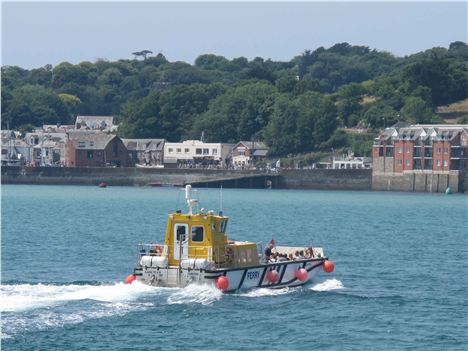 The Rock-Padstow ferry in full chug; below Padstow Harbour
The Rock-Padstow ferry in full chug; below Padstow Harbour
But I was easily outvoted by the rest of the party, keen to take the ferry across the spectacular Camel Estuary to Padstow – and road test Rick Stein’s fish and chips. His commercial predominance in the town (matched only by the ranks of pasty shops) has led the town being dubbed Padstein and certainly the town is up with Mousehole, Mevagissey Looe and the rest as a tourist honeypot. Only odd corners survive what I call Piskyfication (after the trad Cornish fairy). If you like this folkloric thing squeeze into Padstow on Mayday for the famous ’Obby ‘Oss Day, a horse-costumed pagan parade. Pass.
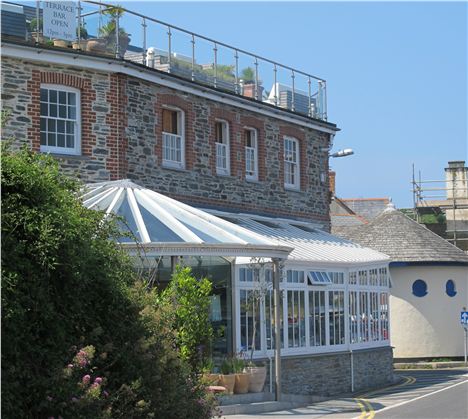 Rick Stein's Seafood Restaurant; below, more of his Padstein empire
Rick Stein's Seafood Restaurant; below, more of his Padstein empire
The Stein fish and chips from his harbour warehouse shop were excellent by the way – a bargain in comparison with his over-rated Seafood Restaurant. Best place to eat in town these days is Paul Ainsworth at Number 6. Or you could just settle for a pasty. They are everywhere. The doorstops of the pastry world.
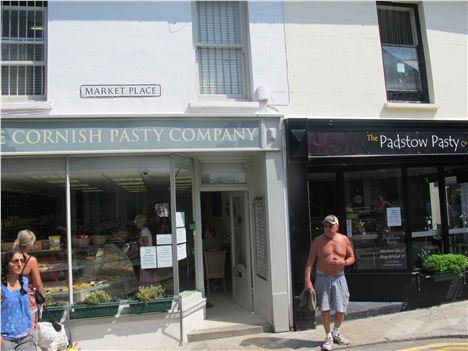 Pastystow – the dining alternative to Stein
Pastystow – the dining alternative to Stein
The food was pretty standard bar fare at the St Kew Inn on the way back, but the wine list was good and the St Austell beers well-kept (I recommend the intense golden bitter, Proper Job). Above all, its beer garden was idyllic in an idyllic village.
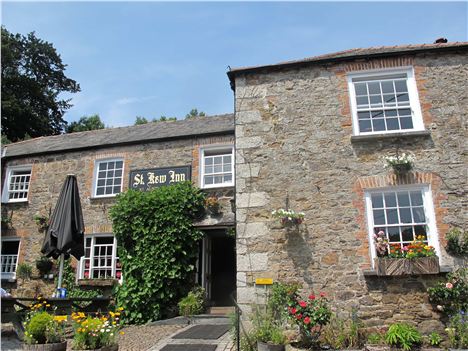 St Kew Inn – an idyllic country inn
St Kew Inn – an idyllic country inn
At St Kew Highway on the nearby A39 the St Kew Harvest Farm Shop provided us with their own organic veg, and some terrific sourdough bread and local cheese. They do their own pork, too. A great place to stock up if you are self-catering.
That is important. We had stopped off on the way down to source good produce big time at the award-winning Darts Farm complex at Topsham, just off the M5 before Exeter. In the sweltering weather fish was off the agenda but we bought meat joints, cheese, bread, vegetables, wines and local beers.
At Ogbeare our “local butcher” was the regionally famous Philip Warren down the B3254 in Launceston, a thriving market town with a castle and steam railway. Fifteen minutes away from Ogbeare into Devon is the sturdy town of Holsworthy (once connected to Bude by canal). Here there’s a huge Waitrose for stocking up at. And it would be wrong not to grab lunch at the welcoming community pub, the Old Market Inn, with a showcase of southwestern real ales and good pub grub.
 Rising Sun on the edge of Bodmin Moor
Rising Sun on the edge of Bodmin Moor
Its only rival in the real ale stakes in this part of the world is at Stratton near Bude, where The Kings Arms, all nooks and Delabole slate floors, has been welcoming travellers since the 17th century. Also try the 16th century Rising Sun. It’s down in the Good Beer Guide as in Altarnun, a beautiful village west of Launceston, but in reality a couple of miles further off, on the edge of Bodmin Moor. Petanque, splendid food and ales from the local Penpont Brewery.
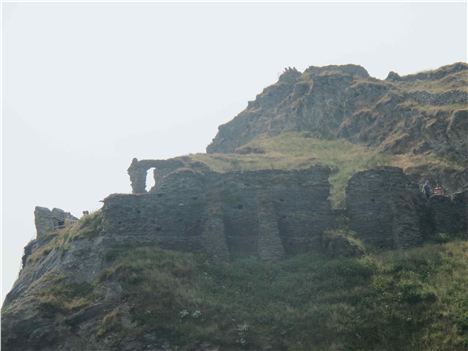 Tintagel Castle – a gaunt relic on a harsh coast
Tintagel Castle – a gaunt relic on a harsh coast
Of course, that unmentionable epic Coastal Path Walk demanded a return to Tintagel. The village itself is an unappealing cluster of pubs, cafes and mystical gewgaw emporia. Oh and nowadays it’s cashing in on being a location for telly’s Doc Martin – images of Martin Clunes are inescapable.
Still take the path down to the Castle remains, a bulwark against the raging seas and it would take the hardest of hearts not to sense the swell of Arthurian legend, the old Cornwall. Just don’t mention Tony Blair.
A contemporary record of the Vicar of Morwenstow, my style guru:
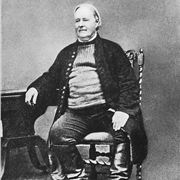 “The Vicar of Morwenstow was a tall and strongly built man with fair hair, blue eyes, and a ruddy complexion. His voice was rich and powerful. He could be heard all over his glebe, and would sometimes carry on a conversation with his neighbours at a farm across the valley. His dress was unconventional and picturesque.
“The Vicar of Morwenstow was a tall and strongly built man with fair hair, blue eyes, and a ruddy complexion. His voice was rich and powerful. He could be heard all over his glebe, and would sometimes carry on a conversation with his neighbours at a farm across the valley. His dress was unconventional and picturesque.
"He absolutely declined to follow the fashions of ‘the cloth’ and would not wear anything black. His usual garb in earlier years was a brown cassock. ‘A blushing brown,’ he said, ‘was the hue of Our Lady’s hair, as typified in the stem of the maiden-hair fern.
"In this cassock he even managed to clamber up and down the cliffs. Later it was exchanged for a long coat of purple shade. Instead of a waistcoat, he wore a fisherman’s blue jersey, in token that he was called a fisher of men. A small red cross was woven in the side, to mark the entrance of ‘the centurion’s cruel spear’.
“These jerseys were knitted for him by a fisherman’s wife at Clovelly. A broad carpenter’s pencil (chosen in reference to the Carpenter of Nazareth) usually dangled from his button-hole. Round his neck he wore a limp white cravat: he could never endure a stiff collar. He carried a cross-handled walking stick, somewhat resembling a wooden sword, which he called his ‘pastoral staff’. Hessian boots and a wide-awake beaver hat completed his out-of-door equipment.”
More about the Reverend: www.robertstephenhawker.co.uk/
Fact file
By car it’s 300 miles from Manchester and Liverpool, five hours (add an hour if you stop at Dart Farm, to stock up and lunch).
Neil Sowerby and family stayed at Ogbeare Coach House, North Tamerton, Holsworthy, Cornwall, EX22. It can be booked through English Country Cottages (www.english-country-cottages.co.uk/0845 268 0788). Ref: HJJQ.
Essential tourist information:
www.visitcornwall.com
www.visitdevon.co.uk
And an excellent new off the beaten track guide book showing the best paces for wild swimming, sunset watching, local food, camping and much more: Wild Guide – Devon, Cornwall and the South West (Wild Things Publishing, pb £14.99).









